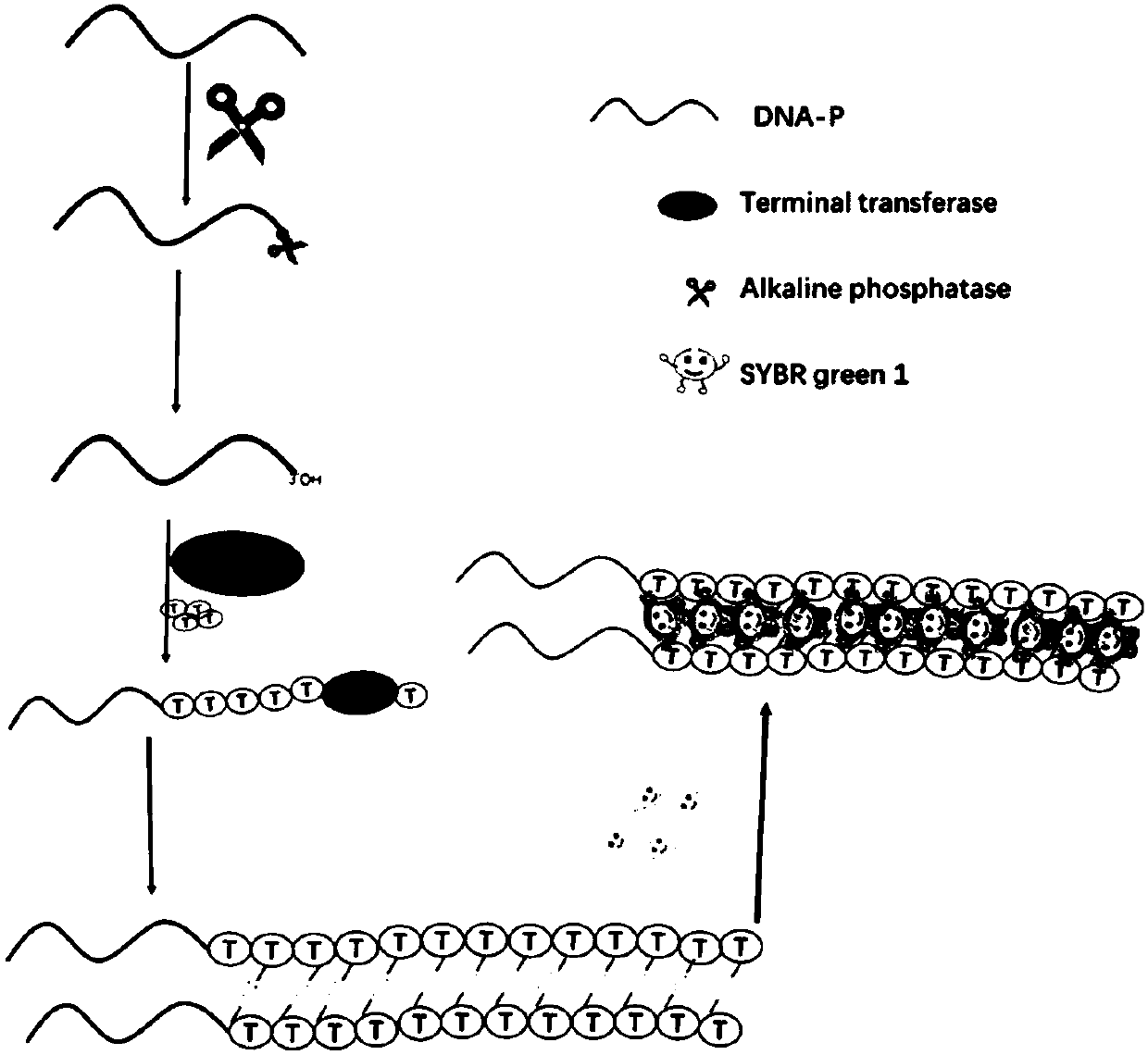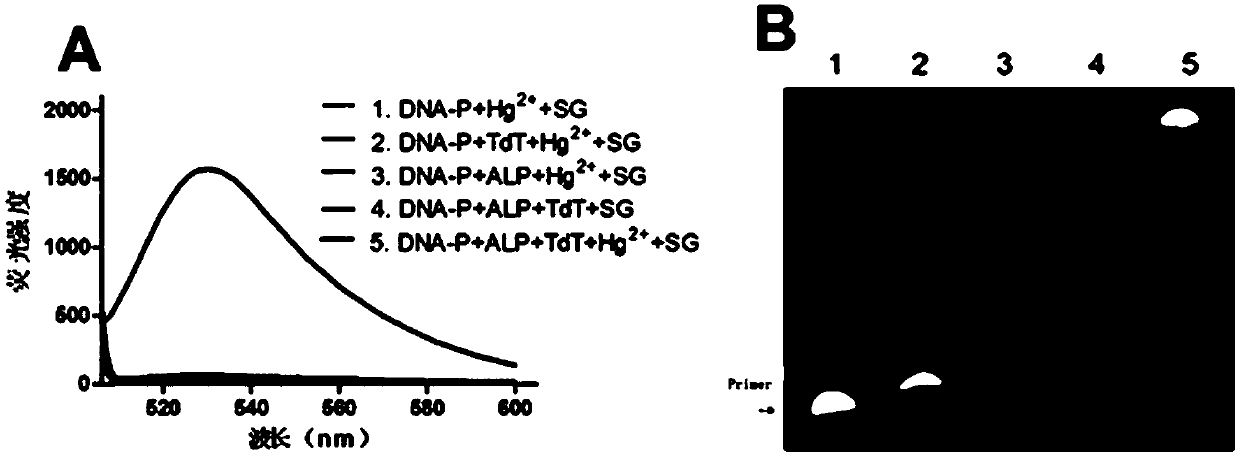Fluorescence chemical method for detecting ALP (Alkaline Phosphatase) and application thereof
A chemical method, phosphatase technology, applied in the field of enzyme activity detection, can solve the problems of time-consuming and toxic operation steps
- Summary
- Abstract
- Description
- Claims
- Application Information
AI Technical Summary
Problems solved by technology
Method used
Image
Examples
Embodiment 1
[0078] Embodiment 1 Principle and feasibility verification of the inventive method
[0079] The detection schematic diagram of alkaline phosphatase (Alkaline phosphatase) of the present invention is as figure 1 As shown, in order to verify the feasibility of the present invention, the inventor detects three important links of the experiment, and the specific process is as follows:
[0080] 1. Terminal deoxynucleotidyl transferase (TdT) can catalyze the addition reaction at the 3'-OH end of ssDNA in a template-free manner. The specific implementation process is as follows:
[0081] (1) A 14nt primer (Primer) ssDNA-2 (5'-ACCCCCCACCCCCA-3') was designed and synthesized by Sangon Bioengineering (Shanghai) Co., Ltd.
[0082] (2) Mix primer ssDNA-2 containing 2.5μM, 1×TdT buffer (20mM Tris-HAc, 50mM KAc, 10mMMg(Ac) 2 , pH 7.9), 250 μM CoCl 2 , 0.75mM dTTPs and TdT (addition amount: 0U, 0.5U, 1U, 2U, 5U, even if the concentration of TdT in the system is 0U / mL, 25U / mL, 50U / mL, 100U...
Embodiment 2
[0097] The optimization of embodiment 2 experimental system
[0098] 1. Condition optimization for the best ratio of dTTPs to ssDNA-p
[0099] In order to achieve the best state of the detection system, we optimize the ratio of dTTPs / ssDNA-p, the steps are as follows:
[0100] According to the method in embodiment 1.3 (feasibility verification) (wherein the consumption of ALP is 2unit in the step (2), the final concentration of TdT is 250U / mL in the step (3), HgCl in the step (4) 2 The final concentration is 2.5μM), and the dTTPs / ssDNA-p molar ratio in the reaction system is set to 4000:1, 5000:1, 6000:1, 7000:1, 8000:1, 9000:1, 10000:1, 12000 :1, 14000:1, and measure the fluorescence intensity signal of the system to be tested.
[0101] The result is as image 3 Shown: by image 3 It can be seen that with the increase of the dTTPs / ssDNA-p ratio, the fluorescence signal enhancement of the detection system increases exponentially. In order to avoid data fluctuations and ob...
Embodiment 3
[0113] Example 3 Alkaline phosphatase activity detection
[0114] The specific implementation process of alkaline phosphatase activity detection is as follows:
[0115] (1) ssDNA-p containing 2.5 μ M primer probe, 1 × ALP buffer, ALP (final concentration of ALP 0 ~ 2500mU / mL; final concentration of ALP selected in this embodiment are: 0mU / mL, 0.025mU / mL, 0.05mU / mL, 0.25mU / mL, 0.5mU / mL, 2.5mU / mL, 5mU / mL, 50mU / mL, 250mU / mL, 500mU / mL, 2500mU / mL) samples were incubated at 37°C For 80 minutes, incubate at 90°C for 10 minutes to inactivate ALP, and finally cool the sample to room temperature for the next reaction.
[0116] (2) Add the sample obtained in step (1) to 5unit TdT (that is, the final concentration is 250U / mL), 1×TdTbuffer, and the final concentration is 250μM CoCl 2 , with a final concentration of 0.75mM dTTPs, mixed and incubated at 37°C for 70min, and then incubated at 72°C for 10min.
[0117] (3) 2.5μM HgCl 2 (final concentration) and the sample obtained in step (...
PUM
 Login to View More
Login to View More Abstract
Description
Claims
Application Information
 Login to View More
Login to View More - R&D
- Intellectual Property
- Life Sciences
- Materials
- Tech Scout
- Unparalleled Data Quality
- Higher Quality Content
- 60% Fewer Hallucinations
Browse by: Latest US Patents, China's latest patents, Technical Efficacy Thesaurus, Application Domain, Technology Topic, Popular Technical Reports.
© 2025 PatSnap. All rights reserved.Legal|Privacy policy|Modern Slavery Act Transparency Statement|Sitemap|About US| Contact US: help@patsnap.com



